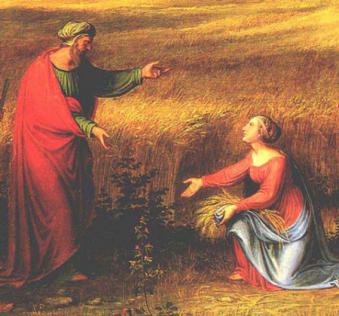Every week, parshaoftheweek.com brings you a rich selection of material on parshat hashavua, the weekly portion traditionally read in synagogues all over the world. Using both classic and contemporary material, we take a look at these portions in a fresh way, relating them to both ancient Jewish concerns as well as cutting-edge modern issues and topics. We also bring you material on the Jewish holidays, as well as insights into life cycle rituals and events...
It is the custom among Jewish communities around the world to read the Book of Ruth on Shavuot. Perhaps the most obvious reason is the fact that the central, dramatic action of the book – Ruth meeting and marrying Boaz – takes place during the period of the grain harvest, which is the season in which Shavuot takes place, and the agricultural event which the holiday marks.
Another explanation is found in the content of the book. The Book of Ruth is a somewhat strange choice for inclusion in the Biblical canon. At first glance, it is a simple family story, revolving around earning a living, marriage and loss, widowhood, family loyalty, and love. The only remarkable aspect of the story would seem to be the fact that the protagonists, Ruth and Boaz, are revealed to be the great-grandparents of none other than King David. Given David’s centrality in the Bible and Jewish history, this explains the inclusion of the book in the canon. But the Rabbis go further, in explaining both its canonization and its connection to Shavuot.
In Midrash Ruth Rabbah, Rabbi Zeira says: “The Book of Ruth contains nothing about ritual impurity or purity; nothing about forbidden or permitted things. Why, then, was it written? To teach you that there is a fitting reward for those who perform acts of loving-kindness.” Rabbi Zeira seems to be referring to Ruth, who showed great love and kindness to her widowed, bereaved mother-in-law, Naomi, and stayed with her even after the death of Ruth’s husband, Naomi’s son. Her reward is her marriage to Boaz, a stand-up guy, who rescues Ruth and Naomi from poverty and shows Ruth true love, along with the fact that her great-grandson is King David. Rabbi Zeira could also be referring to Boaz himself, who treats the Moabite widow Ruth – a potential victim if there ever was one – with respect and generosity, and is rewarded with a wonderful wife and great-grandson.
OK, we get it; this book certainly belongs in the Tanach. But there is more to what Rabbi Zeira teaches us. The central theme of loving-kindness, חסד, and its reward, is not only the central theme of the Book of Ruth, it is also the central theme of the Torah. In Tractate Sotah, 14a, Rabbi Simlai tells us that the Torah, from beginning to end, is about acts of loving-kindness (he brings the examples of God taking the trouble to clothe Adam and Eve after their sin, and to bury Moshe after his death). If this is the case, it makes perfect sense that we read the Book of Ruth, which, Rabbi Zeira has shown us, is all about kindness, on the holiday of the giving of the Torah, which is, ultimately, from beginning to end, all about kindness as well.
I’d like to focus for a moment back on Rabbi Zeira’s statement about the Book of Ruth. “It contains nothing about ritual impurity or purity; nothing about forbidden or permitted things”, it is all about kindness. I believe this formulation, which pits legal, ritual, halachic material against acts of kindness – it doesn’t have this, it has the other – contains an important insight into both our books of kindness, Ruth and the entire Torah. Legal material, by definition, is not “kind”. It is technical, precise, blind to whether you are rich or poor, and contains the constant threat of punishment (which the Torah uses liberally). It would seem to demand to be applied without the interference of kindness, forgiveness, love, or special consideration for the plight of the individual.
We read the Book of Ruth on Shavuot to counteract a very common misreading and misapplication of the Torah, which was given on this day. Ruth reminds us that the central demand of the Torah, and of being Jewish (Ruth is a convert to Judaism, as we all were when we accepted the Torah on Mt. Sinai), is to be kind, considerate, and thoughtful, as Ruth and Boaz were. This is the message of the entire Torah, if read and understood correctly, as Rabbi Simlai shows us – it is about loving-kindness “from beginning to end.” We must not allow ourselves to fall into the trap of thinking that “impure and pure…permitted and forbidden” are what the Torah is all about. These rules are simply the tools, the framework, which we use to accomplish Judaism’s real goal – to be kind, giving, and loving. That is the lens trough which the Torah must be understood, applied, and experienced. An approach which privileges the importance of the “permitted and forbidden” over the consideration of חסד – loving-kindness - is a distortion of the Torah’s true aims, and of the life Judaism wants us to live.
Chag Sameach,
Rabbi Shimon Felix



Get inspired by Shavuot Divrei Torah from previous years